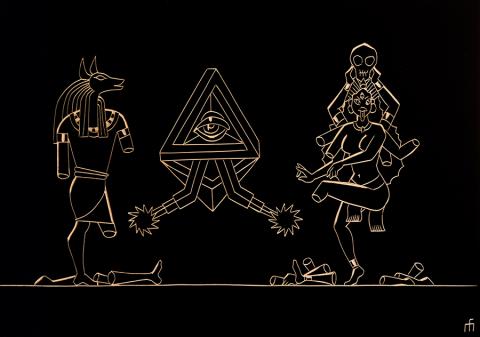Angela Goh, Uncanny Valley, Girl
A couple of years ago I went to see Angela Goh’s Desert Body Creep at the Next Wave festival because it promised to be about worms. Expecting light-hearted multimedia fun, I was unprepared for Goh’s matter-of-fact use of her own body and her incredibly focused interaction with objects. There were epic moments of silence, of stillness, and then there was the jaw-dropping sequence when she stood naked on a vibration machine, butt to the audience, while blasting a heavy metal guitar solo. This genius combination of rippling flesh with guitar shredding was possibly one of the most intense aesthetic experiences of my life. That show, along with Josh Rutter’s Dance Like a Butterfly Dream Boy which I saw in Auckland in 2012, [1] turned my head inside out because neither of them fit my preconceptions of contemporary dance. If anything, they seemed to be doing what visual arts practice was trying to do, but they were doing it better: the whole messy, affective mash-up of the contemporary condition: the body in relation to commodity, materiality and technology. And yet, it’s obvious to me when attending Goh’s latest offering, that I’m still stuck in a visual arts paradigm, only able to see her work in reference to a series of practices, possibly irrelevant, that fire in my brain like flashbulbs as she once again has me mesmerised.
The crowd is ushered down a back alley to get to the featureless room where Uncanny Valley, Girl is about to take place. As we enter and take our seats, Goh is hanging around in casual rehearsal gear, chatting to audience members. Once we are seated, her demeanour changes from animated to her trademark penetrating, yet blank, stare. I’m sure she’s looking at me. I try to return her gaze but I’m nervous and fidgety. Then the lights snap out.
When the lights come up again, she’s back, but completely naked except for a pair of sunglasses. Techno blasts, the lights are a luscious red, and Goh slowly twists her body from side to side, undulating her arms. We are witnessing the birth of a robotic Venus, but at the same time, I can’t get the visual of Linda Benglis’s Artforum ad out of my mind—the perfect slender body, the garish colours, the sunglasses and the ‘fuck you’ attitude. Benglis’s infamous masturbation with a double-sided dildo alluded to artwank and at the same time broadcast loud and clear that you had to have a penis to get into the art world. Uncanny Valley, Girl also includes simulated masturbation, but Goh’s motivation is murkier than Benglis’s one-line bravado. Each of Goh’s finely crafted vignettes features varying objects, music, and lighting, in sequences switching from languorous to abrupt; spellbinding, but ultimately opaque.
Perhaps it’s seeing Goh in conjunction with Unfinished Business at ACCA, and its corollary events, that has me thinking of 1970s feminist performance art. Certainly, Hannah Wilke springs to mind, including the fact that her practice was undermined by contemporaneous feminists as being narcissistic, in spite of Wilke’s willful abjection of herself as object by covering herself in chewing gum ‘cunts’. These works were a kind of cry for help, at least, she titled them S.O.S., for Starification Object Series—ritual scarification on the way to starification. And how do you make it into the hallowed limelight? You strike a pose, you freeze. It’s like vogueing, when you become a picture rather than a person, an idealisation, a symbol. And somehow, the knowing object can become subject, can immobilise the gaze, which is caught in the act, as the music abruptly stops, and cavernous silence reigns. Like the Medusa, both Wilke and Goh have the power to make the viewer freeze.
While Wilke’s willful abjection came in the form of nuggets of gum that looked like sores over her naked flesh, Goh ruptures the aesthetics of a beautiful body moving beautifully in multiple ways: she births a ping pong ball out of her mouth as though it was an alien entity, and when it finally breaches, a cluster of the same balls fall from the cuffs of her jacket; her tongue operates with a mind of its own—a thrashing organ which can only be quashed by a can of ‘mother’ energy drink, which, by the way, is the same toxic lime green as the shiny heeled boots she puts on, and the same virulent colour of the ping pong ball that pops out of her mouth: the very colour of limelight.
Goh’s relationship to objects is deeply fetishistic. They often stand in for absent bodies and perform a ritualised, sexual function. Adhesive silicon bra cups are plastered to a neck massage contraption which, when ‘turned on’ ripples through the simulated fleshy cups so that they look like a swarm of jellyfish, which, apparently, is the only lifeform our warming oceans will be able to support in the not-too-distant future. It’s dystopian but also quite funny and weirdly beautiful. The combination of labouring female bodies and strange objects in machinic assemblages brings to mind Mika Rottenberg’s Squeeze, 2010, which was shown recently at MuMA as part of The Humours. While Rottenberg’s desiring machine was absurdist in the extreme, Goh’s fetishisation of commodities is gently ironic.
Goh’s body moves with eerie precision at a glacial pace. Becoming imperceptible, she is a machine in concert with other machines. The inference that we are witnessing a more-than-human awakening is confirmed at the end when a text by artist and writer Holly Childs scrolls up a screen, an addendum in place of credits, read by a female text-to-speech voice. Childs talks of a ‘mean secret bot’ and a planet ‘in demo mode’. In a ‘simulated Earth’s/ Simulated terrain’ there are ‘programmed dances’. Goh wears the neck massager as a bra, whose coloured lights rotate as she gazes impassively forward, a veritable Stepford Wife. Except that, like those fallible fembots, she exhibits weird tics, such as a strange spasmodic crawling that is simultaneously forwards and backwards—ending in stasis and raw knees. But, as Childs asks us, ‘What does Siri care?’ for ‘She’s laughing and not following commands’.
Uncanny Valley, Girl isn’t cyberfeminism exhorting networked utopian futures, nor is it an enactment of paranoid fears around dystopic simulacra. Yet the ambivalence Goh cultivates is not an ironic cop-out but a passionate attentiveness to a vast spectrum of nuance. As Wilke argued at the end of the decade that produced both her naked performance art and The Stepford Wives, ‘There is an ethics as well as a warning in aesthetic ambiguity.’ [2]
[1] Dance Like a Butterfly Dream Boy is about the performance of masculinity via a series of codes, and can be seen as an initiation rite, and includes dancers and non-dancers, see: https://vimeo.com/106166822
[2] Quoted in Elizabeth Manchester, ‘Hannah Wilke, Marxism and Art: Beware of Fascist Feminism, 1977’, The Tate, http://www.tate.org.uk/art/artworks/wilke-marxism-and-art-beware-of-fasc...

_0-itok=Y-xzOliS.jpg)
_0-itok=itt31T25.jpg)
_0-itok=kCBnJl73.jpg)
_0-itok=NEQe9wze.jpg)
_0-itok=mGGcNYqm.jpg)
_0-itok=g-YLZGKv.jpg)

